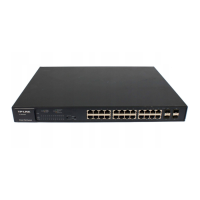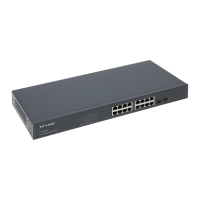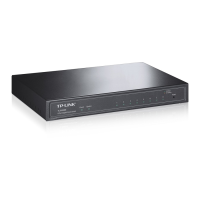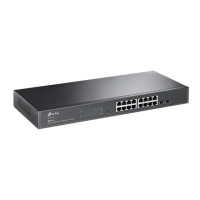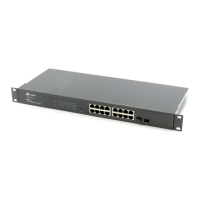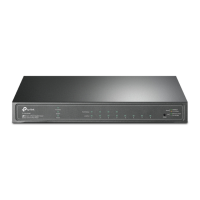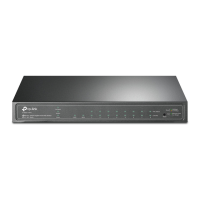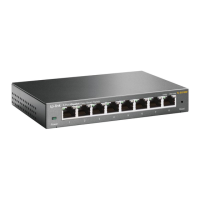Do you have a question about the TP-Link TL-SG2428P and is the answer not in the manual?
Explains choosing between Standalone and Controller modes for switch management.
Details how to access the switch's web interface through web-based authentication.
Describes accessing the switch's CLI via Console, Telnet, or SSH connections.
Introduces the System module for viewing and configuring system parameters and features.
Introduces physical interfaces as ports on the switch panel that forward packets based on MAC address.
Explains LAG (Link Aggregation Group) function for aggregating multiple physical ports into a logical interface.
Details how to complete LAG configuration by configuring the global load-balancing algorithm and static LAG or LACP.
Describes the MAC address table which stores information for forwarding packets based on MAC addresses.
Covers adding static MAC entries, changing aging time, adding filtering entries, and viewing address table entries.
Details steps for 802.1Q VLAN configuration by creating VLANs and configuring port parameters.
Details steps for MAC VLAN configuration: configure 802.1Q VLAN, bind MAC to VLAN, and enable MAC VLAN for ports.
Details steps for Protocol VLAN configuration: configure 802.1Q VLAN, create protocol template, and configure Protocol VLAN.
Details steps for GVRP configuration: create VLAN, enable GVRP globally, and enable GVRP on each port.
Explains Layer 2 multicast, including unicast, broadcast, and multicast packet transmission.
Details steps for IGMP Snooping configuration: global, VLAN, port, and static group configuration.
Details steps for MLD Snooping configuration: global, VLAN, port, and static group configuration.
Introduces Spanning Tree Protocol (STP), Rapid Spanning Tree Protocol (RSTP), and Multiple Spanning Tree Protocol (MSTP).
Details configuring STP/RSTP parameters globally and on ports.
Covers configuring MSTP parameters on ports in CIST, MSTP region, and globally.
Introduces LLDP as a neighbor discovery protocol for advertising device information and LLDP-MED for Auto VoIP.
Details LLDP configuration globally and for ports, including transmit interval, hold multiplier, and TLVs.
Explains configuring LLDP-MED globally and for ports, including Fast Start Repeat Count and TLV selection.
Details configuring IPv4 and IPv6 parameters for Layer 3 interfaces like VLAN, loopback, routed ports, and port-channels.
Details configuring IPv4 static routes via GUI and CLI, including destination, mask, next hop, and distance.
Details configuring IPv6 static routes via GUI and CLI, including destination, prefix length, next hop, and distance.
Introduces DHCP for automatic IP address assignment and supported features like DHCP Server, Relay, and L2 Relay.
Details configuring DHCP Server, including enabling the server, configuring pools, and manual binding.
Covers DHCP Relay configuration, including enabling relay, configuring Option 82, and interface/VLAN relay.
Details ARP configurations including viewing/adding ARP entries, configuring Gratuitous ARP, Proxy ARP, and Local Proxy ARP.
Explains system logs for debugging and network management, with saving options like log buffer, log file, or remote log servers.
Explains choosing between Standalone and Controller modes for switch management.
Details how to access the switch's web interface through web-based authentication.
Describes accessing the switch's CLI via Console, Telnet, or SSH connections.
Introduces the System module for viewing and configuring system parameters and features.
Introduces physical interfaces as ports on the switch panel that forward packets based on MAC address.
Explains LAG (Link Aggregation Group) function for aggregating multiple physical ports into a logical interface.
Details how to complete LAG configuration by configuring the global load-balancing algorithm and static LAG or LACP.
Describes the MAC address table which stores information for forwarding packets based on MAC addresses.
Covers adding static MAC entries, changing aging time, adding filtering entries, and viewing address table entries.
Details steps for 802.1Q VLAN configuration by creating VLANs and configuring port parameters.
Details steps for MAC VLAN configuration: configure 802.1Q VLAN, bind MAC to VLAN, and enable MAC VLAN for ports.
Details steps for Protocol VLAN configuration: configure 802.1Q VLAN, create protocol template, and configure Protocol VLAN.
Details steps for GVRP configuration: create VLAN, enable GVRP globally, and enable GVRP on each port.
Explains Layer 2 multicast, including unicast, broadcast, and multicast packet transmission.
Details steps for IGMP Snooping configuration: global, VLAN, port, and static group configuration.
Details steps for MLD Snooping configuration: global, VLAN, port, and static group configuration.
Introduces Spanning Tree Protocol (STP), Rapid Spanning Tree Protocol (RSTP), and Multiple Spanning Tree Protocol (MSTP).
Details configuring STP/RSTP parameters globally and on ports.
Covers configuring MSTP parameters on ports in CIST, MSTP region, and globally.
Introduces LLDP as a neighbor discovery protocol for advertising device information and LLDP-MED for Auto VoIP.
Details LLDP configuration globally and for ports, including transmit interval, hold multiplier, and TLVs.
Explains configuring LLDP-MED globally and for ports, including Fast Start Repeat Count and TLV selection.
Details configuring IPv4 and IPv6 parameters for Layer 3 interfaces like VLAN, loopback, routed ports, and port-channels.
Details configuring IPv4 static routes via GUI and CLI, including destination, mask, next hop, and distance.
Details configuring IPv6 static routes via GUI and CLI, including destination, prefix length, next hop, and distance.
Introduces DHCP for automatic IP address assignment and supported features like DHCP Server, Relay, and L2 Relay.
Details configuring DHCP Server, including enabling the server, configuring pools, and manual binding.
Covers DHCP Relay configuration, including enabling relay, configuring Option 82, and interface/VLAN relay.
Details ARP configurations including viewing/adding ARP entries, configuring Gratuitous ARP, Proxy ARP, and Local Proxy ARP.
Explains system logs for debugging and network management, with saving options like log buffer, log file, or remote log servers.
| Model | TL-SG2428P |
|---|---|
| Category | Switch |
| PoE Budget | 250 W |
| Switching Capacity | 56 Gbps |
| Forwarding Rate | 41.7 Mpps |
| MAC Address Table | 16K |
| Jumbo Frame | 9 KB |
| Power Input | 100-240V AC, 50/60Hz |
| Storage Temperature | -40°C to 70°C (-40°F to 158°F) |
| Operating Humidity | 10% to 90% non-condensing |
| Storage Humidity | 5% to 90% non-condensing |
| Mounting | Rack Mountable |
| PoE Ports | 24 |
| Dimensions | 440 x 180 x 44 mm |
| Operating Temperature | 0°C to 40°C (32°F to 104°F) |
| Standards and Protocols | IEEE 802.3u, IEEE 802.3ab, IEEE 802.3z, IEEE 802.3x, IEEE 802.3af, IEEE 802.3at, IEEE 802.1d, IEEE 802.1w, IEEE 802.1q, IEEE 802.1p |
| Ports | 24 x Gigabit Ethernet ports, 4 x Gigabit SFP Slots |
